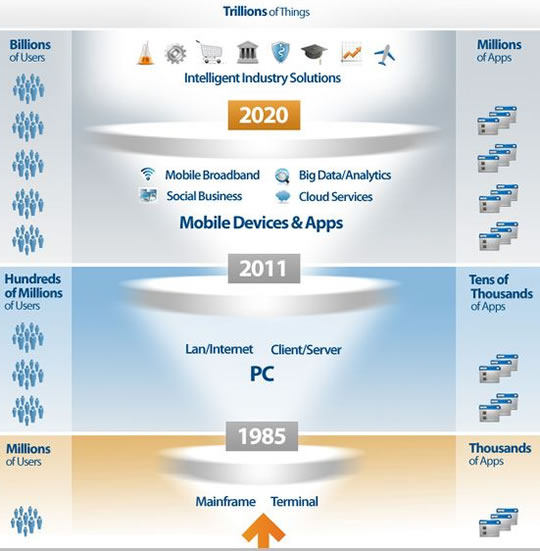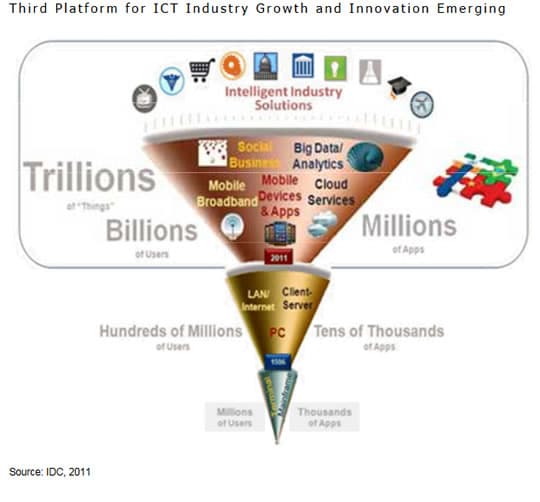Chance is high that by now you have heard about the third platform. If not, you probably will soon as it takes center stage in digital transformation.
At the IDC Directions 2011 event Frank Gens of IDC stressed the impact of the third platform concept, which the research firm coined, and more importantly, emphasized how third platform technologies, or at least the usage/adoption of these technologies by people, is a key so-called disruptive force like none you’ve ever seen in (digital) technology and its impact.
From the first to the third platform
In a nutshell, the third platform is a third stage in IT and its impact on how we work, live and do business.
The first platform is that of the mainframe and the terminals. The second platform brought the client-server model with personal computers, local area networks and the Internet. On a personal note: it’s around the time of the evolution from the first to the second platform that our roots lie, in the overlap of both worlds.
In 2011 IDC stated that we shift to the third platform. Sure, client-server models still exist but again we’re seeing a transition. It’s probably the transition most of the people who read this have known. The third platform consists of various so called pillars: mobile, big data/analytics, cloud computing and social technologies.
A quick look at how we got there:
- There was the advent of faster mobile networks (and ‘smarter’ devices), enabling far better mobility and leading to a mobile first and maybe soon mobile only world.
- A second component was the rise of social technologies in the days when Web 2.0 was still a term we all used to describe a range of Rich Internet Applications and several other technologies, including Flash, which led to the birth of social media and added a layer of interactivity to the Web as we hadn’t seen before. That in turn led us to social business of which social media marketing is just one part and social collaboration, social customer service and social CRM, to name a few, are others.
- On top of mobile and social business two of the four pillars of the third platform – inevitably – are Big Data and Big Data analytics, and last but not least, cloud computing or in the words of IDC: cloud services. The changes and opportunities both have brought upon us are well-known.

The third platform towards meaning, things and rapid expansion
Why would you care about such a concept as the third platform? Well, first of all there is the fact that these four technologies have caused quite a change in how we act, interact, buy, do business and so forth.
Moreover, they did so in a surprisingly rapid and impactful way, among others altering consumer behavior and expectations. It’s in these behavioral shifts and the growing adoption of the four mentioned pillars that quite a bit of so-called disruptive companies and other technologies are rooted.
As an example: if you look at IDC’s original depiction of the third platform (it has changed) you see some additional icons and some data such as billions of users and millions of apps. That is not without consequence of course. Many people, many apps, loads of information that can only be turned into actionable intelligence using again other technologies in the third platform sphere.
And then there are the trillions of things. Whether they will be trillions or billions remain to be seen but it’s clear that on top of and thanks to (new) mobile technologies and forms of connectivity, (big) data analytics capacities, an increasing number of mainly industrial use cases, artificial intelligence to extract meaning, the cloud and several other technology evolutions (including lowering prices for lots of components) the Internet of Things is poised to be another part on top of those four layers. In fact, nowadays add IoT to the third platform.
The third platform, transformation and acceleration
Obviously all these technologies, which cover again many underlying technologies, are inter-connected. These inter-depencies were also emphasized by IDC, in a way that is similar to Gartner’s Nexus of Forces.
Since several years now IDC has been looking at ICT predictions from its third platform angle and things go fast, very fast.
If you look at the evolutions and opportunities behind the third platform (and the risks and challenges) you pretty much have an idea about the evolutions in your industry and, remembering the old saying “it’s not about the technology but about what you can do with it”, can also find how the leverage of this converged reality in which all the mentioned technologies are causing somewhat of an explosion in many areas, drives transformational powers and necessities for several years to come.
This of course always keeping the human, societal and business dimension in mind. Keeping in mind some of the laws of accelerating change and the pace at which the third platform evolves and leads to changes, acceleration is a keyword in the development of the third platform – and whatever might come after that.

More about the third platform
Given the fact that IDC has been using the third platform image (the look did evolve) for several years now, we obviously reported more on third platform evolutions over time.
So, below are some additional resources and texts on the subject.

